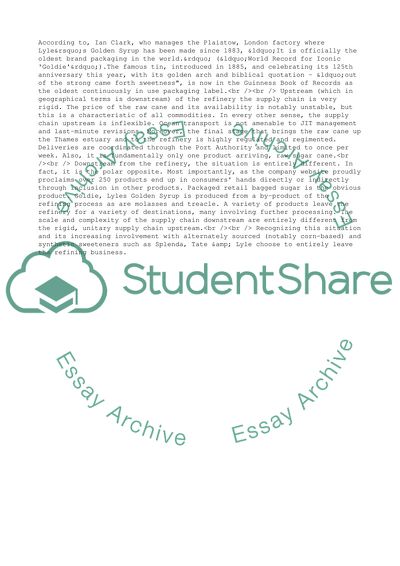Cite this document
(Mass Customisation: Tate & Lyle Case Study Example | Topics and Well Written Essays - 2000 words, n.d.)
Mass Customisation: Tate & Lyle Case Study Example | Topics and Well Written Essays - 2000 words. Retrieved from https://studentshare.org/management/1740895-assess-the-manner-in-which-logistical-challenges-at-tate-and-lyle-silvertown-are-met-and-consider-the-extent-to-which-mass-customisation-could-improve-their-processes
Mass Customisation: Tate & Lyle Case Study Example | Topics and Well Written Essays - 2000 words. Retrieved from https://studentshare.org/management/1740895-assess-the-manner-in-which-logistical-challenges-at-tate-and-lyle-silvertown-are-met-and-consider-the-extent-to-which-mass-customisation-could-improve-their-processes
(Mass Customisation: Tate & Lyle Case Study Example | Topics and Well Written Essays - 2000 Words)
Mass Customisation: Tate & Lyle Case Study Example | Topics and Well Written Essays - 2000 Words. https://studentshare.org/management/1740895-assess-the-manner-in-which-logistical-challenges-at-tate-and-lyle-silvertown-are-met-and-consider-the-extent-to-which-mass-customisation-could-improve-their-processes.
Mass Customisation: Tate & Lyle Case Study Example | Topics and Well Written Essays - 2000 Words. https://studentshare.org/management/1740895-assess-the-manner-in-which-logistical-challenges-at-tate-and-lyle-silvertown-are-met-and-consider-the-extent-to-which-mass-customisation-could-improve-their-processes.
“Mass Customisation: Tate & Lyle Case Study Example | Topics and Well Written Essays - 2000 Words”. https://studentshare.org/management/1740895-assess-the-manner-in-which-logistical-challenges-at-tate-and-lyle-silvertown-are-met-and-consider-the-extent-to-which-mass-customisation-could-improve-their-processes.


